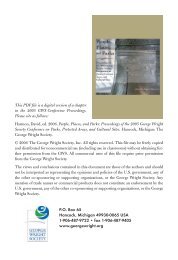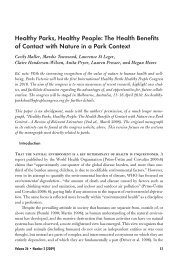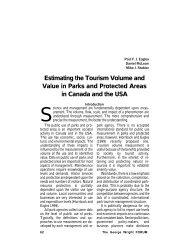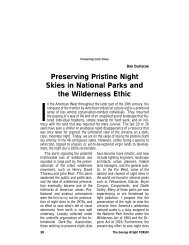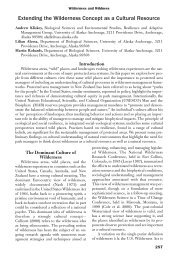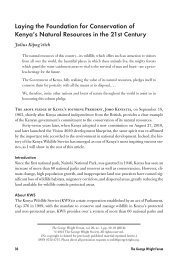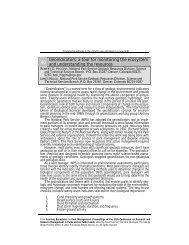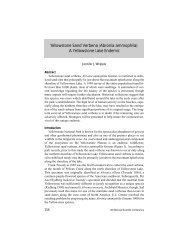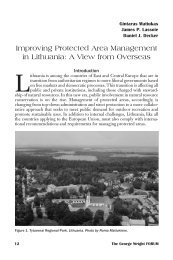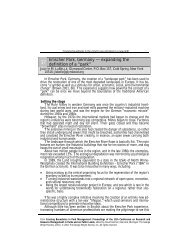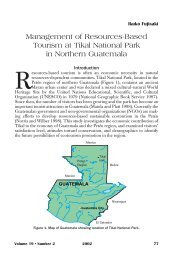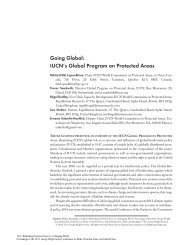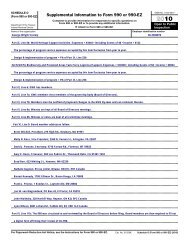Big Egg Marsh Experimental Restoration in Jamaica Bay
Big Egg Marsh Experimental Restoration in Jamaica Bay
Big Egg Marsh Experimental Restoration in Jamaica Bay
Create successful ePaper yourself
Turn your PDF publications into a flip-book with our unique Google optimized e-Paper software.
itor<strong>in</strong>g was accomplished by <strong>in</strong>stall<strong>in</strong>g SETs <strong>in</strong> the treatment site and <strong>in</strong> the control site, with<br />
read<strong>in</strong>gs beg<strong>in</strong>n<strong>in</strong>g one year before the dredg<strong>in</strong>g and cont<strong>in</strong>u<strong>in</strong>g <strong>in</strong>def<strong>in</strong>itely thereafter.<br />
Do<strong>in</strong>g the experimental restoration<br />
Before dredg<strong>in</strong>g and spray<strong>in</strong>g sand on the marsh, a silt fence was <strong>in</strong>stalled around the<br />
low-ly<strong>in</strong>g portions of the perimeter. About 240 hay bales, held <strong>in</strong> place by more than 1,000<br />
wooden stakes and 2,000 m of sisal tw<strong>in</strong>e, provided the primary conta<strong>in</strong>ment (Figure 2).<br />
Where silt runoff became apparent, supplemental conta<strong>in</strong>ment was provided by <strong>in</strong>stall<strong>in</strong>g<br />
100 m of black plastic construction fence for silt control.<br />
The sw<strong>in</strong>g-ladder dredge with high-pressure spray was contracted to pump for 200<br />
hours. Dur<strong>in</strong>g this time, over 6,000 cu 3<br />
of sand were placed on the 1-ha treatment<br />
site. The spray was effectively<br />
delivered to a distance of only 40 m. To<br />
ga<strong>in</strong> additional distance, some slurry was<br />
streamed farther <strong>in</strong>to the marsh <strong>in</strong>terior<br />
by direct<strong>in</strong>g the nozzle horizontally<br />
across the surface of the fresh fill, caus<strong>in</strong>g<br />
the slurry to flow further <strong>in</strong>land. The<br />
placement of the fill was guided by white<br />
polyv<strong>in</strong>ylchloride (PVC) pipes arranged<br />
<strong>in</strong> a grid pattern. Each pipe conta<strong>in</strong>ed an<br />
elevation target marked with red duct<br />
tape and plastic flagg<strong>in</strong>g. Dredg<strong>in</strong>g was<br />
completed by the beg<strong>in</strong>n<strong>in</strong>g of October<br />
2003.<br />
Plant<strong>in</strong>g began on 3 October of that year. Over 20,000 peat pots of smooth cordgrass<br />
were planted by the volunteers and by park staff. These plants were grown on contract with<br />
the Native Plant Center, which is operated by the New York City Department of Parks &<br />
Recreation. Their seed sources were two locations on Staten Island, about 10–30 km from<br />
<strong>Jamaica</strong> <strong>Bay</strong>, but with<strong>in</strong> the New York City harbor. Volunteers cont<strong>in</strong>ued the plant<strong>in</strong>g for<br />
about six weeks, end<strong>in</strong>g <strong>in</strong> late November 2003.<br />
Simultaneously with the plant<strong>in</strong>g, green plastic fence was erected to keep geese from<br />
devour<strong>in</strong>g the new plants. Geese regularly dig out smooth cordgrass by the roots dur<strong>in</strong>g the<br />
w<strong>in</strong>ter, and graze the fresh green growth throughout the grow<strong>in</strong>g season. To prevent this on<br />
the restoration site, volunteers and NPS staff <strong>in</strong>stalled about 700 m of fence on 260 wooden<br />
posts. The fences were arranged <strong>in</strong> cells of about 20 m diameter, to make it difficult for geese<br />
to land or take off with<strong>in</strong> the fences. Additionally, mason’s woven str<strong>in</strong>g with surveyor’s plastic<br />
flagg<strong>in</strong>g were stretched overhead to further subdivide the cells. Repairs had to be done<br />
repeatedly dur<strong>in</strong>g the w<strong>in</strong>ter, due to damage from float<strong>in</strong>g debris (wrack, wood debris, and<br />
ice), w<strong>in</strong>d, and waves.<br />
Results<br />
The U.S. Geological Survey is read<strong>in</strong>g the SETs at approximately three-month <strong>in</strong>ter-<br />
126 • People, Places, and Parks<br />
Figure 2. Before spray<strong>in</strong>g sand on the <strong>Big</strong> <strong>Egg</strong> <strong>Marsh</strong> restoration site,<br />
240 hay bales were staked across the dra<strong>in</strong>ages to conta<strong>in</strong> the runoff of<br />
silt and organics.



